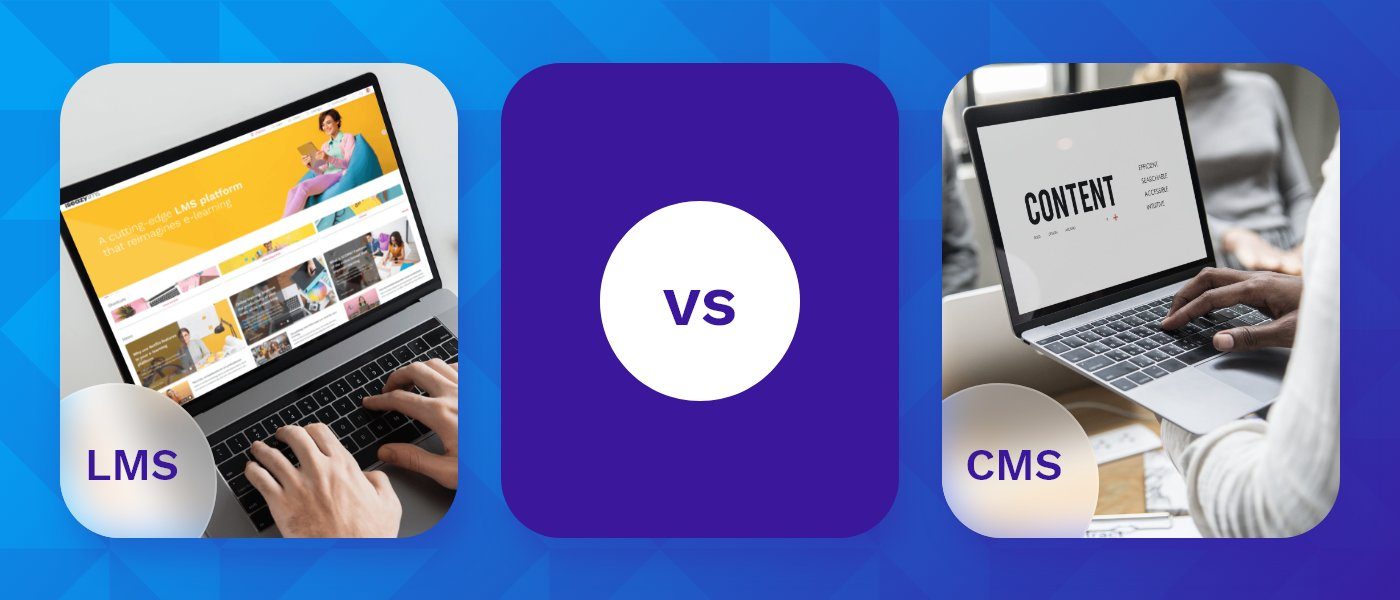Table of contents
ToggleWhen it comes to choosing a platform to manage e-learning content, doubts can often arise over the large number of options available on the market. However, making the right decision on which technology to use can be achieved based on a careful consideration of its approaches and functionalities.
Two of the most popular options today are LMS, or learning management systems, and CMS, or content management systems. In this article, we will explain what LMS and CMS are – their differences, functionalities and advantages – and help you to choose the most suitable platform according to your needs.
What is an LMS?
Learning management systems, or LMS, are platforms designed to manage, store and monitor the whole online learning process. They act as centralized hubs for the delivery of courses and training content, making them the perfect place to store content, assign it to other users, and track their progress.
Although desktop LMS do exist, the most popular are cloud-based, which means that information is not stored on physical hardware, but rather hosted on an internet server.
What is a CMS?
On the other hand, a content management system, or CMS, is used to create, manage and publish online content. These types of systems are very versatile, since they allow for the creation and editing of different types of content, such as blogs, web pages and more.
And although they can be used to host educational content, for example an educational blog, they do not specifically focus on learning management itself. Their main purpose is the creation of all types of web page, but they do simultaneously offer other functionalities such as storage and control of data analysis.
LMS vs. CMS: Key Features and Differences
Now that you know what an LMS and a CMS are, let’s get to know their differences more closely:
Approach
As we have seen, the main difference between these two systems is that an LMS focuses on managing and administering the learning process – that is, it offers a focused platform for the delivery of educational courses or training content. A CMS, on the other hand, is used to create, manage and publish general online content, which may or may not concern teaching specifically.
Content creation
LMSs do not allow you to create content directly, since their main purpose is to manage learning. So, if you use an LMS and your intention is to create training material from scratch, you will also need a content creation tool that you can then import and store in your system.
By contrast, CMSs come with built-in authoring tools that make it easy to create digital content, such as web pages or blogs, and that also allow content to be shared in different formats.
SCORM export format
Whilst we’re on the subject of formats, here is the third difference between the two systems (and one of the most important). LMSs typically support exporting in SCORM (Sharable Content Object Reference Model) format, which is a standard format used in the education industry to create reusable content compatible with multiple different learning management systems.
This format is in fact the most used in the e-learning industry, since most training content is indeed SCORM compatible. CMSs, on the other hand, do not offer this functionality.
Collaborative editing
Finally, since they do not include content creation functionality or authoring tools, LMSs do not allow for collaborative editing. CMSs, for their part, do allow multiple users to work on the same content simultaneously, which is perfect for collaborative work.
Advantages of using an LMS in the educational field
LMSs are the most used platforms in e-learning, both in the field of formal education and in business training, and this is due to their multiple advantages:
Flexibility
The main advantage of these platforms is their flexibility in the delivery of educational content, since through an LMS it is possible to offer online courses, learning modules and more to students, at any time and from any location. This enhanced flexibility also opens the doors to accessibility, as well as personalization of learning.
Ease of use
The best LMSs are designed to be intuitive and easy to use for both instructors and students. This means that any user can take advantage of these platforms without requiring advanced computer knowledge.
Organization
LMSs provide ideal tools for organizing and managing course content. You can structure your courses, plan them by year or by quarter, allocate resources and track your students’ progress efficiently.
Compatibility with multiple devices
Another advantage of these platforms is that they are usually compatible with a wide variety of devices. This allows students to access content from desktop computers, tablets and mobile phones, thus increasing accessibility and allowing trainers to adopt various teaching methodologies, such as microlearning or blended learning.
Personalized tracking
Finally, thanks to their great ability to track student progress, LMSs offer personalized feedback and the option of adapting training material to individual student needs.
How to choose the best LMS?
Choosing the best LMS for your team training depends on your specific needs. However, here are some tips to help you make an informed decision:
- Define your objectives: Start by identifying your teaching and learning objectives. What results do you hope to achieve with your learning platform?
- Evaluate the system’s features: Analyze the specific features you need in your LMS, such as user management, the ability to export in SCORM format, or tracking features such as completion rates, scores, and goal achievement.
- Costs and scalability: Consider aspects such as your budget and the scalability of the platform as your user base grows.
- Test various options: Test as many platforms as you need to evaluate their ease of use and compatibility with your goals.
If you still don’t know where to start, isEazy LMS is an excellent option! Engage your collaborators in training with a platform totally focused on user experience, and improve their engagement, progress and completion rate.
Furthermore, isEazy LMS allows you to manage your training content in the most comfortable, easy and intuitive way – comprehensively covering all your communication, training and corporate knowledge needs. Request a demo!












